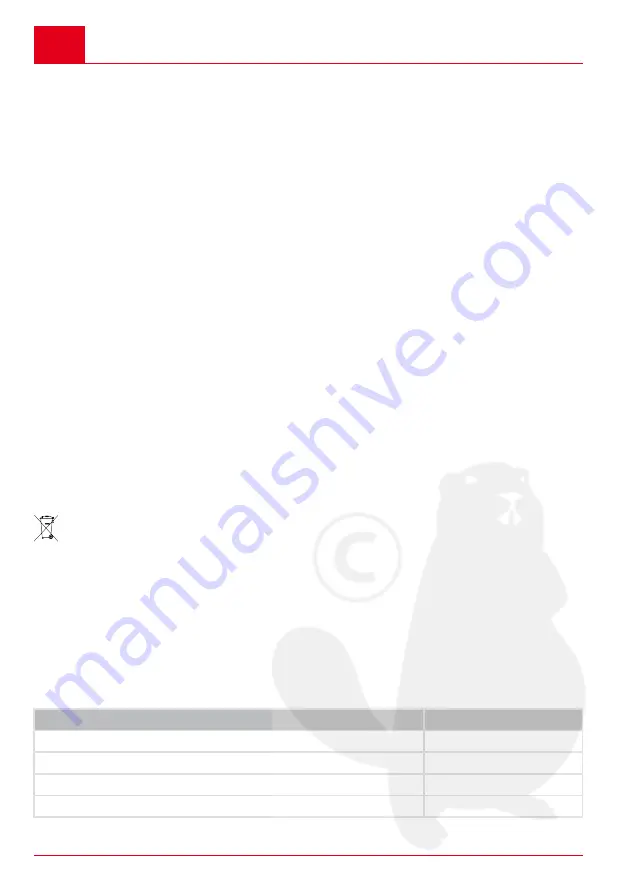
GB
44
CS 4030
Technical data
■
Used batteries or rechargeable batteries that
are not installed permanently in the old appli-
ance must be removed before disposal. Their
disposal is regulated by the battery law.
■
Owners or users of electrical and electronic
appliances are obliged by law to return them
after use.
■
The end user bears personal responsibility
for deleting his personal data from the old ap-
pliance to be disposed of.
The symbol of the crossed-through rubbish bin
means that electrical and electronic appliances
may not be disposed of in the household rubbish.
Electrical and electronic appliances can be hand-
ed in at the following places at no charge:
■
Public service disposal or collection points
(e.g. municipal building yards)
■
Points of sale of electrical appliances (sta-
tionary and online) provided traders are
obliged to take them back or offer this volun-
tarily.
These statements only apply to appliances that
are installed and sold in the countries of the Eu-
ropean Union and are subject to European Direc-
tive 2012/19/EU. Different provisions may apply
to the disposal of electrical and electronic appli-
ances in countries outside the European Union.
Information on the German Battery Act
(BattG)
■
Used batteries and rechargeable bat-
teries do not belong in household
waste, but should be collected and dis-
posed of separately.
■
For safe removal of batteries or rechargeable
batteries from the electrical appliance and for
information on their type or chemical system,
follow the further information within the oper-
ating or installation instructions.
■
Owners or users of batteries and recharge-
able batteries are obliged by law to return
them after use. Return is limited to the han-
dover of customary household quantities.
Used batteries can contain harmful substances or
heavy metals that can cause damage to the envi-
ronment and human health. Reuse of the used
batteries and use of the resources contained
therein contributes to the protection of these two
essential commodities.
The symbol of the crossed-through rubbish bin
means that batteries and rechargeable batteries
may not be disposed of in household rubbish.
In addition, if the symbol Hg, Cd or Pb appears
under the rubbish bin, this stands for the follow-
ing:
■
Hg: Battery contains more than 0.0005 %
mercury
■
Cd: Battery contains more than 0.002 % cad-
mium
■
Pb: Battery contains more than 0.004 % lead
Rechargeable batteries and batteries can be
handed in at the following places at no charge:
■
Public service disposal or collection points
(e.g. municipal building yards)
■
Points of sale of batteries and rechargeable
batteries
■
Disposal points of the common take-back
system for the used batteries of appliances
■
Disposal point of the manufacturer (if not a
member of the common take-back system)
These statements apply only to rechargeable bat-
teries and batteries that are sold in the countries
of the European Union and that are subject to
European Directive 2006/66/EU. Different provi-
sions can apply to the disposal of rechargeable
batteries and batteries in countries outside the
European Union.
20 TECHNICAL DATA
Type
CS 4030
Item no.
113616
Idling speed
17 m/s
Operating speed
16 m/s ± 0.7 m/s
Length of the guide rail
approx. 350 mm
Summary of Contents for CS 4030
Page 3: ...469861_c 3...
Page 4: ...4 CS 4030...
Page 5: ...469861_c 5...
Page 210: ...UA 210 CS 4030 15 4 14 15 226 16 226 17 227 18 227 19 227 20 228 21 229 22 229 1 1 1 2 2 1 2 2...
Page 213: ...469861_c 213 3 3 3 4...
Page 214: ...UA 214 CS 4030 3 5 3 6 4...
Page 215: ...469861_c 215 5 6...
Page 216: ...UA 216 CS 4030 10 C 7 8 AL KO AL KO...
Page 217: ...469861_c 217 9 AL KO 8...
Page 218: ...UA 218 CS 4030 10 10 1 16 10 2 10 3 2 5...
Page 224: ...UA 224 CS 4030 19 18 14 3 19 20 1 3 10 1 3 11 14 4 12 15...
Page 227: ...469861_c 227 AL KO AL KO 17 1 2 3 4 18 30 19 ElektroG 2012 19 C...
Page 230: ...230 CS 4030...
Page 231: ...469861_c 231...
















































